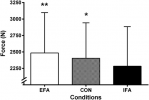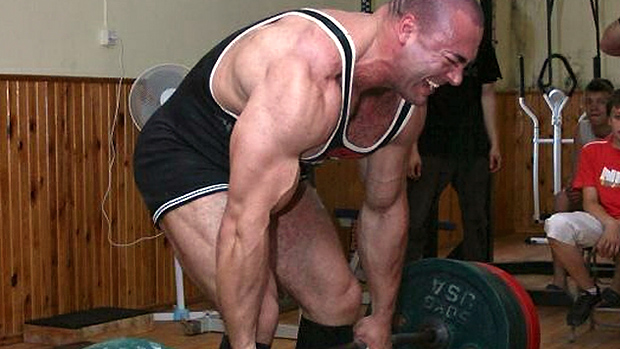Kenny Croxdale
Level 7 Valued Member
The Effects of Attentional Focusing Instructions on Force Production During the Isometric Midthigh Pull
The Effects of Attentional Focusing Instructions on Force... : The Journal of Strength & Conditioning Research

Figure 1
Demonstrates the absolute mean (SD) force differences between 3 instructional conditions: external focus of attention (EFA), control instruction (CON), and internal focus of attention (IFA).
The observed outcomes support previously published findings demonstrating the negative effects of IFA on performance during activities requiring high force and power production. For example, instructing subjects to focus on the vanes of the Vertec device (EFA) led to enhanced jumping performance compared with focusing on the tips of the fingers (IFA) (23), with comparable results reported for horizontal jumps (21). When resistance-trained subjects focused on exerting force against a loaded barbell (EFA) they completed more repetitions in the free weight bench press and squat exercises compared with focusing on exerting force with the legs or arms (IFA) (12). Similarly, focusing on the isokinetic dynamometer lever arm (EFA) led to greater elbow flexion torque compared with focusing on the arm muscles (IFA) (13). Finally, trained athletes were able to throw a shot put further after instruction to focus on throwing to a visible target (EFA) compared with focusing on extending their arms rapidly (IFA). When the athletes were asked to focus on performing the task to the best of their abilities (control), their performance was also better than IFA (10).
The results of this study are consistent with the constrained action hypothesis proposed by Wulf (22,24). This hypothesis proposes that EFA promotes an automatic motor response, that is, in line with the desired outcome, whereas IFA directs participants to be conscious of their movements, which disrupts the automatic control of the involved motor systems. Particularly, it can be speculated that IFA instructions led athletes to focus on just one component of a complex movement that is typically completed by an integration of many muscles and body parts. Thus, IFA may degrade the overall contribution of other body parts and muscles leading to suboptimal performance. In contrast, the EFA encourages athletes to organize all the relevant contributors around the task (a) without omitting any one of the contributors and (b) allowing greater automaticity of the movement.
Although studies have examined the effect of attentional focusing instructions on maximal force production activities, to the best of our knowledge, this study is the first to investigate this question with the IMTP test. This study demonstrated the significance of verbal instructions on the performance of this test with a clear observation that EFA instruction enhanced performance. Common guidelines on the verbal instructions for the IMTP emphasize the need to perform it hard and fast. This guideline is based on a number of studies that have shown better performance with the combination of these words compared with emphasizing a single word in isolation (2,3,18). However, few, if any, studies referred to the attentional feedback literature when discussing verbal instructions during the IMTP. In fact, one guideline suggests focusing on contracting as hard as possible throughout the maximal effort isometric test (14). Collectively, IFA instructions should generally be avoided, whereas EFA instructions should be favored during physical performance tests and exercises that require maximal levels of force and/or power, such as the IMTP.
The Effects of Attentional Focusing Instructions on Force... : The Journal of Strength & Conditioning Research
Abstract
Halperin, I, Williams, KJ, Martin, DT, and Chapman, DW. The effects of attentional focusing instructions on force production during the isometric midthigh pull. J Strength Cond Res 30(4): 919–923, 2016—Verbal instructions play a key role in motor learning and performance. Whereas directing one's attention toward bodily movements or muscles (internal focus) tends to hinder performance, instructing persons to focus on the movement outcome, or an external object related to the performed task (external focus) enhances performance. The study's purpose was to examine whether focus of attention affects maximal force production during an isometric midthigh pull (IMTP) among 18 trained athletes (8F & 10M). Athletes performed 3 IMTP trials a day for 3 consecutive days. The first day was a familiarization session in which athlete's received only control instructions. The following 2 days athletes received either control, internal, or external focus of attention instructions in a randomized, within-subject design. Compared to performance with an internal focus of attention, athletes applied 9% greater force when using an external focus of attention (p < 0.001, effect size [ES] = 0.33) and 5% greater force with control instructions (p = 0.001, ES = 0.28). A small positive 3% advantage was observed between performances with an external focus of attention compared with control instructions (p = 0.03, ES = 0.13). Focusing internally on body parts and/or muscle groups during a movement task that requires maximal force hinders performance, whereas focusing on an object external to the self leads to enhanced force production, even when using a simple multi joint static task such as the IMTP.
Figure 1
Demonstrates the absolute mean (SD) force differences between 3 instructional conditions: external focus of attention (EFA), control instruction (CON), and internal focus of attention (IFA).
Discussion
We report that IFA instructions lead to substantial decrements in peak force production compared with both EFA (9%) and control (5%) conditions in motivated trained athletes. Furthermore, EFA instructions result in a significantly greater (3%) peak force than control instructions. Considering that the athletes were trained and motivated and that the IMTP is a reliable and relatively simple test, the 9% difference in peak force output between EFA and IFA is a small meaningful effect. Although males were found to be considerably stronger than females (29%), both genders responded to a set of instructions in a similar fashion.The observed outcomes support previously published findings demonstrating the negative effects of IFA on performance during activities requiring high force and power production. For example, instructing subjects to focus on the vanes of the Vertec device (EFA) led to enhanced jumping performance compared with focusing on the tips of the fingers (IFA) (23), with comparable results reported for horizontal jumps (21). When resistance-trained subjects focused on exerting force against a loaded barbell (EFA) they completed more repetitions in the free weight bench press and squat exercises compared with focusing on exerting force with the legs or arms (IFA) (12). Similarly, focusing on the isokinetic dynamometer lever arm (EFA) led to greater elbow flexion torque compared with focusing on the arm muscles (IFA) (13). Finally, trained athletes were able to throw a shot put further after instruction to focus on throwing to a visible target (EFA) compared with focusing on extending their arms rapidly (IFA). When the athletes were asked to focus on performing the task to the best of their abilities (control), their performance was also better than IFA (10).
The results of this study are consistent with the constrained action hypothesis proposed by Wulf (22,24). This hypothesis proposes that EFA promotes an automatic motor response, that is, in line with the desired outcome, whereas IFA directs participants to be conscious of their movements, which disrupts the automatic control of the involved motor systems. Particularly, it can be speculated that IFA instructions led athletes to focus on just one component of a complex movement that is typically completed by an integration of many muscles and body parts. Thus, IFA may degrade the overall contribution of other body parts and muscles leading to suboptimal performance. In contrast, the EFA encourages athletes to organize all the relevant contributors around the task (a) without omitting any one of the contributors and (b) allowing greater automaticity of the movement.
Although studies have examined the effect of attentional focusing instructions on maximal force production activities, to the best of our knowledge, this study is the first to investigate this question with the IMTP test. This study demonstrated the significance of verbal instructions on the performance of this test with a clear observation that EFA instruction enhanced performance. Common guidelines on the verbal instructions for the IMTP emphasize the need to perform it hard and fast. This guideline is based on a number of studies that have shown better performance with the combination of these words compared with emphasizing a single word in isolation (2,3,18). However, few, if any, studies referred to the attentional feedback literature when discussing verbal instructions during the IMTP. In fact, one guideline suggests focusing on contracting as hard as possible throughout the maximal effort isometric test (14). Collectively, IFA instructions should generally be avoided, whereas EFA instructions should be favored during physical performance tests and exercises that require maximal levels of force and/or power, such as the IMTP.
Practical Applications
The reported results offer practical and relevant information for sports scientists and coaches, which can be applied to learning and maximizing performance. The IMTP is a test that requires the application of maximal force and is commonly used to monitor training progress and to design training programs. The results point to the importance of maintaining consistency with verbal instructions across testing days because of their substantial effects on performance even during a relatively simple isometric, complex multi joint exercise. Specifically, instructing athletes to “contract” an activated muscle group hinders performance and should be avoided, whereas instructing athletes to focus on an external object or device enhances performance and should be strongly encouraged.
Last edited:

